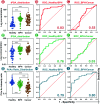Standard-free single magnetic bead evaluation: a stable nanoplatform for prostate disease differentiation
- PMID: 35733887
- PMCID: PMC9159090
- DOI: 10.1039/d2sc00928e
Standard-free single magnetic bead evaluation: a stable nanoplatform for prostate disease differentiation
Abstract
Explicit interpretation of heterogeneity between prostate-specific antigen (PSA) subtypes is essential for prostate cancer differentiation during different disease courses, whereas a universal protocol with uniform criteria is still lacking across the globe. In this work, a standard-free single magnetic bead (SMB) nanoplatform utilizing metal nanoparticles with optimal diameters was proposed for prostate disease differentiation in a 134-donor model. The inaccuracy of detection in absolute quantification was diminished via evaluations of metal intensities on the single magnetic bead. The intrinsic proportion of fPSA in tPSA was successfully evaluated by direct use of the Pt to Au intensity ratio (Pt/Au ratio), exhibiting better differentiation between healthy and unhealthy, benign prostatic hyperplasia (BPH) and cancer individuals compared with solo fPSA or tPSA. We generated thresholds respectively for prostate disease differentiation, envisioning that this standard-free SMB nanoplatform would establish a standardized methodology with uniform criteria worldwide in cancer diagnosis, staging, and postoperative assessments.
This journal is © The Royal Society of Chemistry.
Conflict of interest statement
There are no conflicts to declare.
Figures





Similar articles
-
Determination of alpha1-antichymotrypsin-PSA complex in serum does not improve the differentiation between benign prostatic hyperplasia and prostate cancer compared with total PSA and percent free PSA.Urology. 1999 Jun;53(6):1160-7; discussion 1167-8. doi: 10.1016/s0090-4295(99)00080-1. Urology. 1999. PMID: 10367846 Clinical Trial.
-
Ratio of alpha 1-antichymotrypsin--prostate specific antigen to total prostate specific antigen in prostate cancer diagnosis.Anticancer Res. 2000 Nov-Dec;20(6D):4997-5001. Anticancer Res. 2000. PMID: 11326657
-
Ratio of free or complexed prostate-specific antigen (PSA) to total PSA: which ratio improves differentiation between benign prostatic hyperplasia and prostate cancer?Clin Chem. 2000 Jan;46(1):55-62. Clin Chem. 2000. PMID: 10620572
-
Comparison of the clinical validity of free prostate-specific antigen, alpha-1 antichymotrypsin-bound prostate-specific antigen and complexed prostate-specific antigen in prostate cancer diagnosis.Eur Urol. 2001 Jan;39(1):57-64. doi: 10.1159/000052413. Eur Urol. 2001. PMID: 11173940
-
Screening for prostate cancer in 2008 II: the importance of molecular subforms of prostate-specific antigen and tissue kallikreins.Eur Urol. 2009 Mar;55(3):563-74. doi: 10.1016/j.eururo.2008.11.040. Epub 2008 Nov 29. Eur Urol. 2009. PMID: 19058905 Review.
References
LinkOut - more resources
Full Text Sources
Research Materials
Miscellaneous

